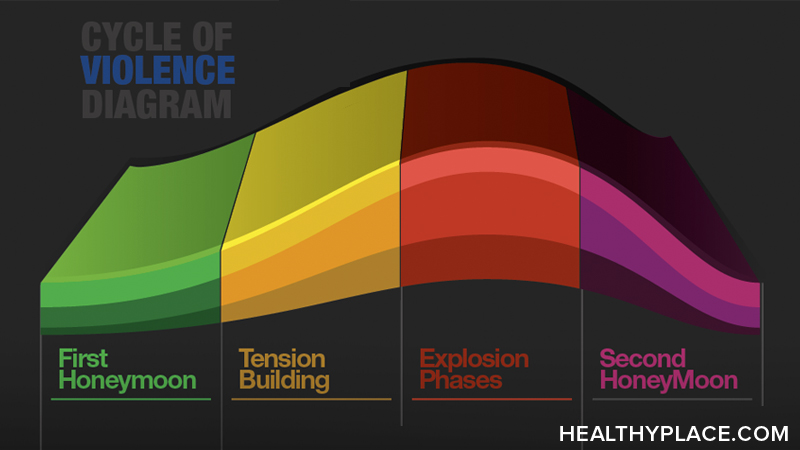Cycle of Violence and Abuse and How to Break the Cycle of Abuse

A common cycle of abuse begins to take hold once domestic violence starts in a relationship. Your partner apologizes, you lower your guard, and over time, the violence rears its ugly head once again. Understanding the signs of domestic violence and causes of domestic abuse are crucial to breaking this domestic violence cycle. (Wondering "Am I in the cycle of violence? Take the Domestic Violence Test)
Taking the First Spin Around the Cycle of Violence
"That slap across my face was just a one-time thing," you think, completely oblivious to the cycle of violence that has just entered your life. The first physical assault may shock you, but most victims will accept their abuser's apologies and excuses, easily setting the stage for a cycle of abuse to flourish.
Early signs of impending domestic violence center around your abuser spouting out insults, preventing you from talking to family or friends, and controlling every aspect of your life -- from how you spend your money to what food you eat. Watch for major red flags like your partner showing an angry side when drunk, regularly acting jealous and possessive of you, and even threatening to hurt you. Stay vigilant so you'll notice these signs, and ready yourself to end the relationship, when violence enters the picture.
How Does the Domestic Violence Cycle Work?
The basic parts of a domestic violence cycle see an abuser threaten violence, strike his victim, apologize, and promise to change, before starting the cycle all over again. To break it down even more, simply take a look at a standard cycle of abuse wheel. The abuse begins with a slap, punch, kick or some other violent action, all intended to show the victim exactly who's in charge.
Yes, at its core, domestic violence is a power play. The violent act is followed up by guilt, not for hurting you but merely for the chance of being caught and punished for his actions. This guilt leads to the domestic abuser making rational excuses for what he's done. Stress. Drinking. Miscommunication. He'll come up with any and every excuse for his actions to avoid actually taking responsibility. Next, in the power and control wheel, domestic violence takes a backseat while the abuser moves on as if nothing happened.
Getting the relationship back on track is key to him, as the abuser will act as normal as he can, showering the victim with gifts, attention, and anything else he can muster up to make her forget his actions and believe that he truly has changed. Unfortunately, the victim thinks he's the most sincere during this time. While she's letting her guard down and moving on with the relationship, the abuser may secretly dream about hurting her again and begin plotting his next violent act. The final step in the domestic violence cycle occurs when the abuser sets up the victim to create a scenario where he's completely justified in hurting her.
Breaking the Cycle of Abuse Takes Strength
The most difficult part of a violent relationship is breaking the cycle of abuse. The constant apologies and remorse from your partner can make it extremely tough to sever things and go your separate ways. He's apologized so many times. He bought you roses, made a really romantic dinner and even wrote a beautiful love poem. "He's not a violent man," you think. "There's no way he'd hurt me again." But sure enough, he'll go through the same motions again, bringing the cycle of violence full circle.
The longer you stay in this dangerous abusive relationship, the more violent he will become and the tougher it will be for you end things. You'll quickly find yourself getting more depressed and nervous, and you may even start believing his lies, thinking his violent actions are justified and you do deserve it.
Whether you've been hit once or you've been carrying the physical and mental scars of abuse for years, the first step in ending abuse comes down to one thing: tell someone. Talk to a neighbor, a friend, a relative, anyone who will listen – including the National Domestic Violence Hotline. Be strong and get your story told. Whether you decide to end your relationship or not, you can get the help you need to move on, breaking the cycle of abuse.
There is never any excuse for domestic abuse. None. But all too often, women fall victim to it. Not wanting to believe their partner is truly violent, they look past the first punch, keeping the abuse cycle going in full swing. By being observant, strong, and communicative, breaking the cycle of violence is possible, enabling women to move on with their lives.
APA Reference
Gluck, S.
(2021, December 17). Cycle of Violence and Abuse and How to Break the Cycle of Abuse, HealthyPlace. Retrieved
on 2024, June 20 from https://www.healthyplace.com/abuse/domestic-violence/cycle-of-violence-and-abuse-and-how-to-break-the-cycle-of-abuse



